By Carl Zulauf
Department of Agricultural, Environmental and Development Economics
Ohio State University
Krista Swanson, Gary Schnitkey, and Nick Paulson
Department of Agricultural and Consumer Economics
University of Illinois
This article discusses acres enrolled in CRP (Conservation Reserve Program), including acres accepted for 2021 sign up. Compared with the acres enrolled in CRP as of July 31, 2021; 2021 accepted acres emphasize the Grassland CRP sub-program. The Appendix contains a brief description of CRP and its 3 sub-programs: General CRP, Continuous CRP, and Grassland CRP.
CRP acres: As of July 31, 2021, 20.6 million acres were enrolled in CRP (see Figure 1) (USDA, FSA (US Department of Agriculture, Farm Service Agency), 2021c). Sub-program shares were General CRP (54%), Continuous CRP (37%), and Grassland CRP (9%).
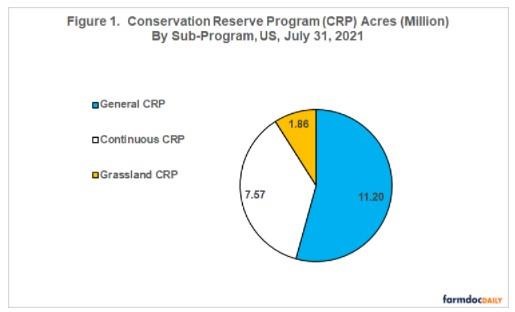
All but 2 (Illinois and Mississippi) of the 15 states with the most acres enrolled in CRP are west of the Mississippi River (see Figure 2). The 6 states that lie on the north-south longitude from Texas to North Dakota account for 41% of CRP acres. Texas has the largest individual state share at 11%.
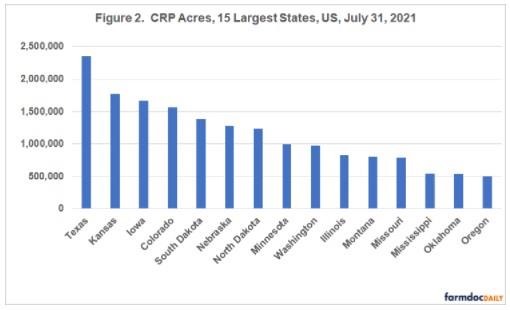
Changes for 2021 Sign Up: Changes for General and Continuous CRP included greater flexibility in soil rental rates (increased in some situations), a 10% life-of-contract increase in rental rate, and 3%, 5% or 10% incentive payments for adopting practices designated as sequestering more carbon and reducing greenhouse gas emissions. The latter included establishment of trees and permanent grasses, development of wildlife habitat, and wetland restoration. For Continuous CRP only, the incentive payments for adopting water quality benefiting practices was increased from 10% to 20%. For Grassland CRP, a $15/acre minimum rental rate was established and National Grassland Priority Zones were designated with a focus on migratory corridors and environmentally sensitive areas. For a complete list of 2021 sign up changes, see the “What’s New” factsheet (USDA, FSA, 2021b).
2021 Accepted Acres: Acres accepted for General CRP totaled 1.9 million (USDA, FSA, 2021c). Half were in Texas, Colorado, and Kansas while 92% were in the 15 states with the most accepted acres (see Figure 3). Note, an accepted acre is not necessarily a future enrolled acre as an owner can opt out of an accepted offer before the enrollment period starts.
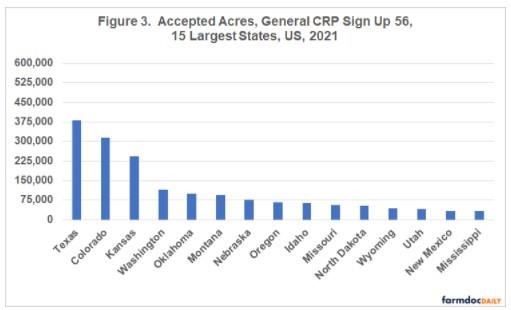
Acres accepted into Grassland CRP totaled 2.5 million (USDA, FSA, 2021c). Colorado, South Dakota, and Nebraska accounted for 54% while 99% were in the 15 states with the largest accepted acres (see Figure 4).
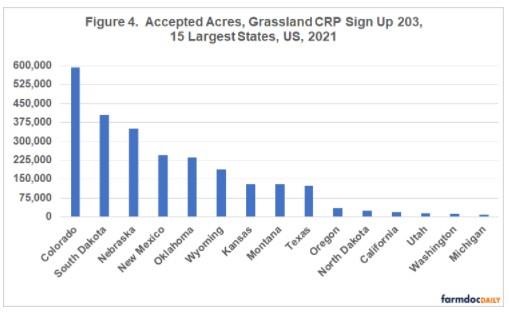
Figure 5 contains the difference between a state’s share of combined acres accepted into General and Grassland CRP in 2021 and its share of acres enrolled in CRP as of July 2021 for states with a share difference of 1 or more percentage point (pp). Colorado stand outs. Its 2021 acceptance share was 13 pp greater than its July 2021 enrollment share (20.5% vs. 7.6%). On the other hand, Iowa’s share difference was -7.6 pp (0.5% vs. 8.1%). The 7 states with a +1 or more pp difference were among the 8 states with the largest 2021 grassland sign up (compare Figures 4 and 5). This relationship is not surprising since Grassland CRP accounted for 58% of Grassland and General CRP 2021 accepted acres but only 9% of enrolled CRP acres as of July 31, 2021.
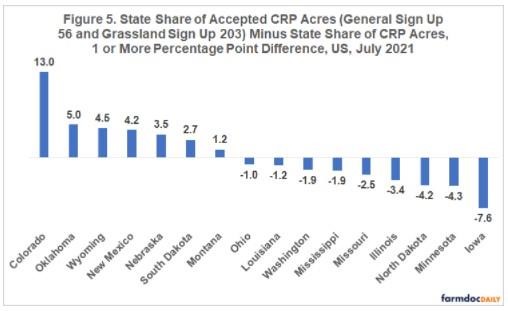
USDA, FSA (2021f) has also reported that 897,000 acres have been accepted for enrollment in the Continuous CRP as of August 23, 2021. No state breakout is available at present.
Summary Observations
The Conservation Reserve Program (CRP) is a conservation portfolio program.
General CRP is arguably the sub-program most associated with CRP with its historic emphasis on removing highly erodible whole fields from crop production. However, only slightly more than half of current enrolled CRP acres are in the General CRP.
Over one third of enrolled CRP acres are in the Continuous CRP. It couples environmentally beneficial farm practices to a specific site, often a sub-field area, to achieve environmental benefits while keeping some to most of the field in production.
Grassland CRP, currently the smallest of the 3 sub-programs, had the largest share of 2021 accepted acres. Potential reasons for high sign up are establishment of a minimum US Grassland CRP rental rate, high crop prices that limited interest in enrolling cropland in CRP, and low profitability in cattle.
Given the wide-spread interest in carbon sequestration, an interesting policy question is how much additional carbon will be sequestered because of the 2021 sign up. This question is of particular interest for the acres accepted into the Grassland CRP since many were probably used as pasture.
Source : illinois.edu